Uni High 8th Graders Grow Big Idea Projects to Make a Difference in Local Community Gardens
June 14, 2017
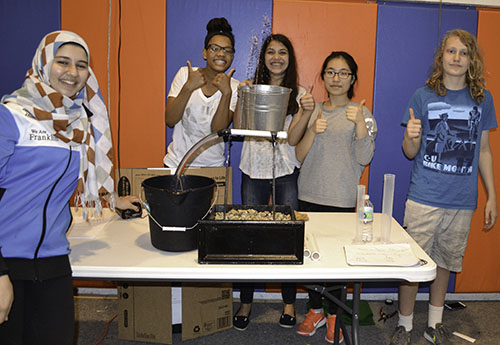
Uni High 8th graders demonstrate howtheir project, "Minimizing Microbial Contamination in Rainwater Collection and Storage" works.
This past semester Sharlene Denos planted the seed of innovation in her University Laboratory High School (Uni High) 8th grade science students. In collaboration with local Champaign-Urbana community gardens, and funded by the Illinois Learning Sciences Design Initiative (ILSDI), her students unearthed problems encountered by managers of the gardens, then, based on science learned in school, as well as via research, got to work on how to effectively solve these problems. While the science aspect of their projects was important, the main focus was really on the design element.
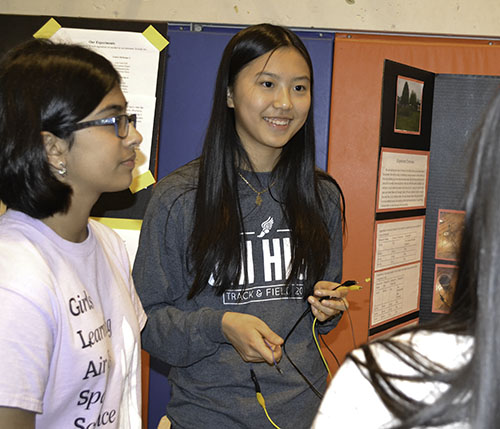
A team of students share about their project, "Portable Urban Gardening Bed with Circuit Moisture Sensor," with visitors.
Denos’ goal was to have teams of students in her classes do science-related, user-oriented-design service projects for one of three community gardens: Randolph Street Community Garden run by Don Blackman; Prosperity Gardens run by Nicole Bridges; and Douglas Community Center Organic Garden run by Katie Hicks. So she wrote a proposal which was funded by ILSDI, an interdisciplinary, university-wide organization, whose funding is derived from the overhead from NSF grants. “It’s seed money that brings an interdisciplinary group together around interesting ideas and design education,” Denos explains, “with the idea that they would then take that initial work and turn it into something bigger, an externally funded grant.
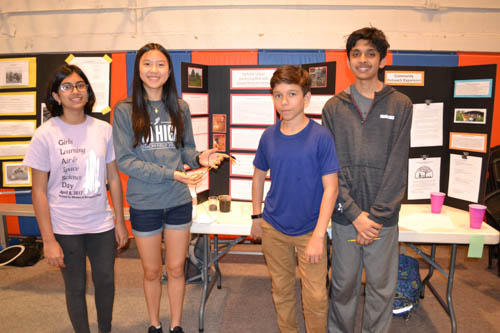
University High 8th graders present their poster presentations.
Denos came up with the idea for the class when she noticed that she hadn’t really had any students in her previous classes who could use maker types of technology: electronics, CADing or 3D printing. Then she had an epiphany: "You know it'd be great to front load some of that training so that when the kids go to think about prototyping their ideas, they think, ‘Oh, you know what? I could easily laser cut these pieces,’ and they know how to do it.”
So she decided to write a proposal, Making a Difference (which she calls “kind of cheesy,”) but she says was about “How do you take these extracurricular, after-school, maker-type experiences kids can have and bring them into—not a technology class—but a science class. So you make it a really authentic science experience…When the kids are trying to make design decisions, they have to design and perform a control experiment. Then they have to learn about heat transfer, or they have to learn about hydrostatic pressure.”She reports that they’re all learning about different things, depending on what their design concept is.
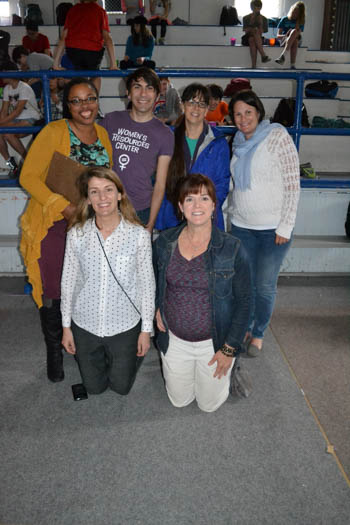
Sharlene Denos, (front left) and several of the educators involved with her community gardens project.
While the premise of the user-oriented design concept was to have her students consider their clients’ needs and the usability of their design, she claims the projects were “really driven by the kids’ ideas.”
“It needs to be driven by the kids’ ideas,” Denos stresses, “because I want to empower the kids.” By “empower” she means to raise her students’ confidence and critical thinking. She’s hopeful their thought process is somewhat along the lines of, “’Okay, I may not have a deep scientific background, but I can still think through a problem. Given a certain framework, I can think through it and come up with good ideas that I can then test using scientific processes. That's the bottom line of what they do: they come up with an idea.”
Denos says there’s also a service component to the project, which is working with the directors of local community gardens to solve problems they’ve encountered: “You are working with a user; you’re doing that problem; you’re identifying that authentic problem.”
But while her students worked with the user to define their problem, she indicates they didn't work with the user to develop the solution because they didn’t have time.
Do her kids come up with something that’s doable? “Usually it's crazy,” Denos admits. “If we have time, we work with the user to narrow it down to something reasonable, but either way it's fine.”
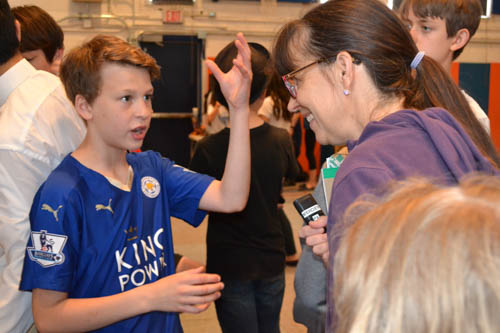
University High 8th grader explains his findings to Illinois researcher Barbara HUG.
One of the key components to this process was that the students define “a really authentic problem.” So, to help the eighth graders come up with an idea, Uni High juniors acted as mentors, helping the younger students develop surveys for the users (the garden directors), to identify problems they might want to solve. After an initial meeting, the garden directors then came to the school and gave presentations to the students. Denos also took her students on a field trip to the gardens, so they could measure things, take pictures, and talk to the garden directors. Student teams also communicated with the directors through email correspondence.
After identifying an authentic problem, the students then brainstormed different solutions on how to solve the problem. And just like any other real-world problem, one constraint students had was a limited budget. In fact, Denos shares that in an interaction with one client, “When we asked what our budget was, she said basically, $0.’…All the garden directors told us…‘Oh, basically anything that you propose, I'm going to have to go and write a proposal!’… So we're just operating with the idea that we want to make it cheap!” admits Denos. So her students learned to justify decisions they made based on their data and the budget.
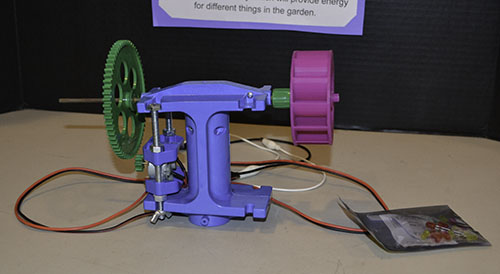
A water wheel designed by one of the teams which would provide electrical energy to power something in the garden.
What kind of projects did her kids come up with? For one project, titled, “Electrical Power Systems Through Rainwater Irrigation,” the team designed a water wheel to be placed beneath gutters (designed by another team). The idea was that as rain water flows onto the waterwheel, it would cause it to spin, and the resultant energy would be transferred to a battery which would provide energy for the garden.
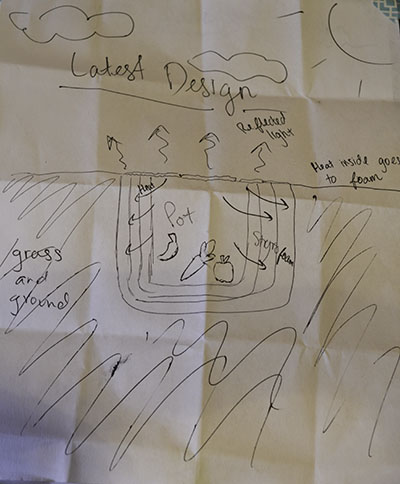
The latest design of how the team's passive refrigeration container works.
Another group did a passive refrigeration container for the Randall Street community garden in a project they called, "Thermodynamics in Underground Storage." They designed something similar to a cellar that could be lowered into the ground and be kept relatively cool with no use of machinery or energy. Denos explains their thought process:
“We've looked at thermal profiles of the soil,” she says, “so they know if you go down a few feet that you can get a really standard 55-60 degrees pretty much all year round. So what they're imagining is this box that you can just lower down, and then it has an insulated lid of just foam and then a reflective top so then it reflects the rays.”
How did her student know the most effective way to achieve passive refrigeration?
“Well, this is a science class,” Denos explains. She goes on to explain that they learned about the three different categories of heat transfer: convection, conduction, and radiation.
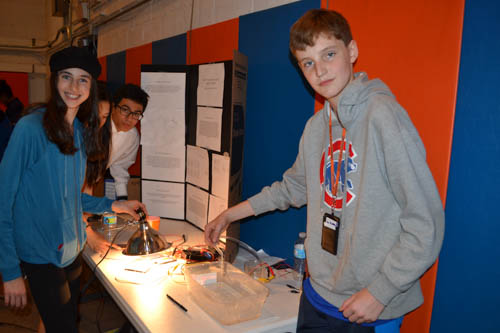
Students display an experiment about their findings from studying heat transfer.
Using this knowledge, they determined that all three were relevant to their problem: “Because there's radiation from the sun, and they want to reflect the rays away; and then they have conduction through the earth, direct contact between the rocks and the earth; and then they have convection from the air above that's making contact with the top of the box. So they have to consider all of these things.”
This group of students then went on to perform experiments where they simulated the air with hot water. Regarding the insulation, she says “And they try to see, depending on the thickness of the foam, how long it takes for the two temperatures to be the same.” Based on these data, they then calculated which materials and how much materials were significantly effective to their passive refrigeration.
Another group of students who designed a greenhouse learned about optics. “So they have to think about, ‘What do you want a greenhouse to do?’” Denos asks.
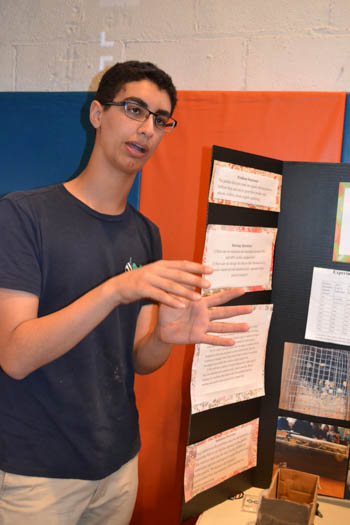
A student explains his poster presentation.
She goes on to explain that you would want a material that allows visible light, or photons through. but won’t let the infrared light out.
“That would be perfect for a greenhouse,” Denos continues, “because you're letting all the light in, and it’s absorbed, then it's reemitted as infrared, but the window won’t pass infrared and it reflects it back in so it keeps all the heat inside. And that's the greenhouse effect.” So her students were testing different materials to find which one would do that best.
This entire process truly encapsulates the vision of Denos’ and Emma Mercier Making a Difference proposal, where students do user-oriented-design service projects to learn science. Plus, Denos is teaching her students to not make rash decisions solely based off their ideas, but to analyze the data and learn more about the topic they’re trying to solve in order to most efficiently and effective solve their problem.
Denos best sums up the big picture as “They’re trying to take their idea and then find the science in their idea.”
Also involved with the project was Susan Kelly, a Curriculum and Instruction doctoral student who helped with data collection. Kelly reports that she and the project PI, Emma Mercier, a Curriculum and Instruction Assistant Professor, were "interested in how a project based learning project played out in a classroom context."
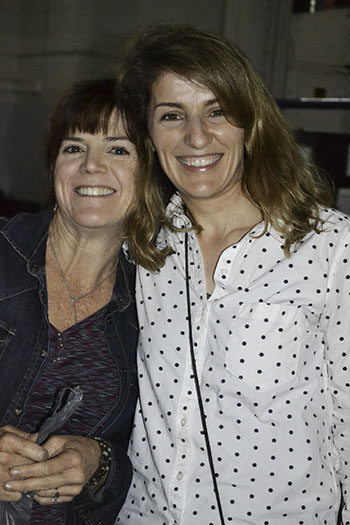
Susan Kelly and Sharlene Denos enjoy the poster session.
Kelly, who helped with some aspects of the project coordination and with the field trip to the gardens, believes that the project helped build university-community partnership. "I think the project was a great connection to the local community and to the garden directors, and this relationship with continue to grow with future iterations of the project."
She goes on to share how the project was beneficial to the students:
"I think the project helped the students to see how engineering design principles could be applied in a local context to solve a community need. The students were exposed to ways that science and engineering play out in an authentic context, and they learned something about the process of 'doing science,' and that designing and experimenting is an iterative process. Thinking about the project through the eyes of the user, and designing with community needs in mind, was an important take away from the project."
Story and photos (unless noted) by Elizabeth Innes, Communications Specialist, I-STEM Education Initiative
More: 6-8 Outreach, Champaign-Urbana Community, University Laboratory High School, 2017
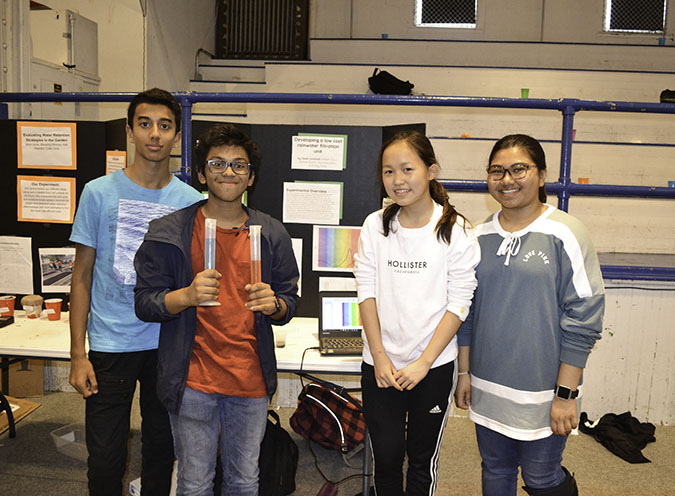
A team of students prepare to explain their project, "Developing a Low-Cost Rainwater Filtration Unit."













.jpg)
















